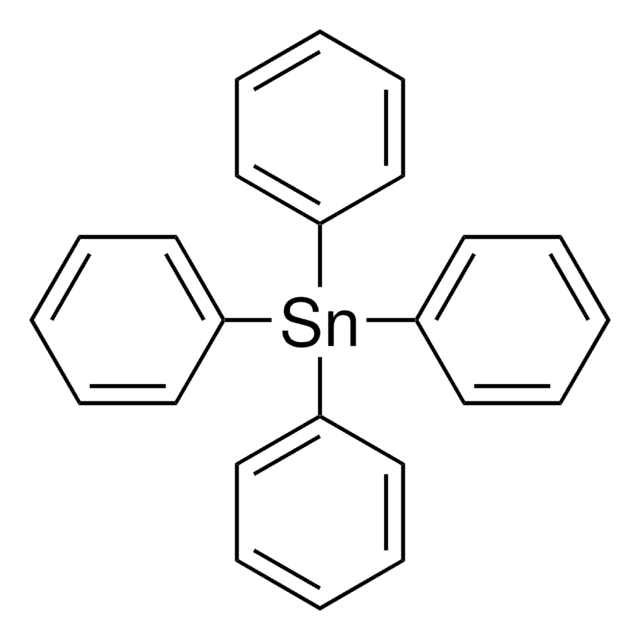208930
Tin(IV) chloride
98%
Synonim(y):
Stannic chloride fuming
About This Item
Polecane produkty
gęstość pary
9 (vs air)
Poziom jakości
ciśnienie pary
10 mmHg ( 10 °C)
18.6 mmHg ( 20 °C)
20 mmHg ( 22 °C)
Próba
98%
Postać
liquid
przydatność reakcji
core: tin
reagent type: Lewis acid
reagent type: catalyst
tw
114 °C (lit.)
mp
−33 °C (lit.)
gęstość
2.226 g/mL at 25 °C (lit.)
ciąg SMILES
Cl[Sn](Cl)(Cl)Cl
InChI
1S/4ClH.Sn/h4*1H;/q;;;;+4/p-4
Klucz InChI
HPGGPRDJHPYFRM-UHFFFAOYSA-J
Szukasz podobnych produktów? Odwiedź Przewodnik dotyczący porównywania produktów
Powiązane kategorie
Opis ogólny
Zastosowanie
- Cyclization of trans β-monocyclohomofarnesic acid to form norambreinolide.
- Formation of C-glycosides of aromatic compounds such as thiophene, naphthalene and phloroglucinol trimethyl ether.
- Formal [4+2] cycloaddition of 3-ethoxycyclobutanones and allyltrialkylsilanes to form 3-ethoxy-5-[(trialkylsilyl)methyl]cyclohexan-1-ones.
- Diastereoselective reaction of δ-alkoxyallylstannanes with aldehydes to form 1,5-diol derivatives.
Other applications of SnCl4:
- The SnCl4-2,6-dialkoxyphenols complexes can catalyze cyclization of poylenes, such as 4-(homogeranyl)toluene to form trans-fused tricyclic compound.
- SnCl4 can act as a promoter during the reaction of ortho-aminobenzonitriles with β-ketoesters and β-enaminonitriles to form 4-aminoquinolines and 4-aminopyridines, respectively.
- SnCl4-silver perchlorate forms an effective catalytic system for the stereoselective of glycosylation 1-O-acetyl glucose.
Hasło ostrzegawcze
Danger
Zwroty wskazujące rodzaj zagrożenia
Zwroty wskazujące środki ostrożności
Klasyfikacja zagrożeń
Aquatic Chronic 3 - Eye Dam. 1 - Skin Corr. 1B - STOT SE 3
Organy docelowe
Respiratory system
Kod klasy składowania
8A - Combustible corrosive hazardous materials
Klasa zagrożenia wodnego (WGK)
WGK 1
Temperatura zapłonu (°F)
Not applicable
Temperatura zapłonu (°C)
Not applicable
Środki ochrony indywidualnej
Faceshields, Gloves, Goggles, type ABEK (EN14387) respirator filter
Certyfikaty analizy (CoA)
Poszukaj Certyfikaty analizy (CoA), wpisując numer partii/serii produktów. Numery serii i partii można znaleźć na etykiecie produktu po słowach „seria” lub „partia”.
Masz już ten produkt?
Dokumenty związane z niedawno zakupionymi produktami zostały zamieszczone w Bibliotece dokumentów.
Klienci oglądali również te produkty
Nasz zespół naukowców ma doświadczenie we wszystkich obszarach badań, w tym w naukach przyrodniczych, materiałoznawstwie, syntezie chemicznej, chromatografii, analityce i wielu innych dziedzinach.
Skontaktuj się z zespołem ds. pomocy technicznej








